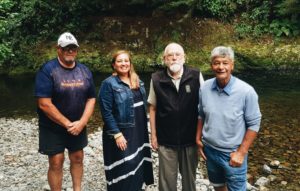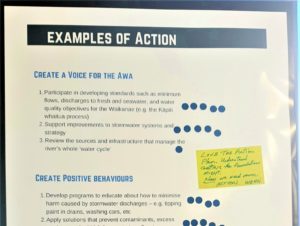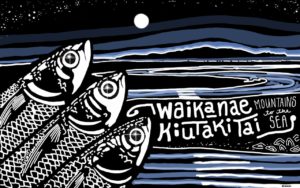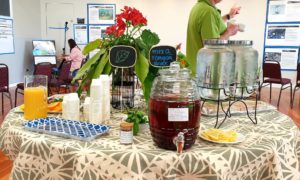Working together for community wellbeing through revitalising the Waikanae Awa
Waikanae Ki Uta Ki Tai is a project about working together to
catalyse community wellbeing centred on revitalising the whole of
the Waikanae Awa.
Our Vision
Our vision is of Waiora; this community working together, under a treaty house partnership, to enhance the lifeforce, vitality and special nature of the whole of the Waikanae Awa.
We see the river as a living whole of which the community is an intertwined part. By protecting and revitalising the river, our community identity, wellbeing and prosperity are also enhanced.
Our Mission
We want to build on all the efforts to protect and restore the river so far. In the spirit of Treaty partnership, our mission is to create a voice for the whole awa. We will do this by catalysing more connection, cohesion and capacity for work towards our vision.
Who Are We?
We are a unique local group set up to start the project. We bring together community members who know the river, Ātiawa ki Whakarongotai Iwi and Government Agencies (Kapiti Coast District Council KCDC, Greater Wellington Regional Council, GWRC and Department of Conservation, DOC).
Together, we are learning how to work in partnership under the Treaty of Waitangi, for the benefit of the river and the community connected to it.
What do we mean by “the Awa”?
The Awa is more than you think.
We share a very wide understanding about what the Waikanae Awa is.
• It is not just now – it is knowledge handed down and history. It is the patterns, rhythms and flows of processes like flooding, erosion, fish migration, and seasons. It is the future, down the generations.
• It is not just the water – it is the landforms, rocks and soils. It is the vegetation cover, the wildlife, and the habitats. It includes all the forms of land use, from those who make a living off the land to those of us who live on the land in our houses.
• It is not just the river and the riverbed – it is the entire catchment above and below; the flows of the water from
the sky, through the earth and in the plants, animals and people that live in it and drink it. It is out to sea. It is the water that flows out of the physical catchment to provide our tap water and comes back in as wastewater.
• It is people – it is the connection with the Awa that we all share, the spiritual values, the place to fish, the place to play, the identity for our district, the knowledge we have about the values and stresses of the Awa. It is this understanding of the Awa that determines the scope of the project.
Ngā mātāpono
Our values
These are the six powerful values that are shared by both the Iwi and the community that honour the river and underpin this work.
Based on these shared values, we propose six priority objectives for the revitalisation of the Waikanae Awa.
Ngā mātātika
Our priority objectives
Objective: Support our shared connection to the Waikanae Awa, making it central to our Community’s identity and prosperity.
……….
Whakapapa is about lineage, descent and connections.
For local iwi Te Āti Awa ki Whakarongotai, their intergenerational relationship to the Waikanae Awa has fundamentally informed their collective identity. As Mana Whenua they whakapapa to te Taiao and whakapapa implies their inherited responsibility as kaitiaki to care for all that is living and existing within their rohe. The Awa has provided kai, and a place to heal and immerse in nature. It is important to be aware that some spaces are to be left alone, to show reverence for certain historical events that have occurred.
The community too is intertwined with the Awa, making it central to their identity and prosperity. The Awa is a living ancestor.
Together, we can be good ancestors for our mokopuna by caring for the Awa
Objective: Support innovation in the use of land and water so that the Awa/Waikanae has room to breathe and flourish.
……….
Mana is about authority, influence and strength.
Mana is the authority that Te Ātiawa ki Whakarongotai holds as mana whenua and the responsibilities that come with it. Their ability to exercise their kaitiakitanga appropriately greatly affects their mana.
Mana flows through strong relationships through Te Tiriti between Iwi and Kawana.
The community recognises that the Awa has authority. We all need to prioritise its needs so it can sustain us all.
The Waikanae Awa has its own integrity and value. The awa has the power to bring our community together.
Together we can provide an influential voice for the Awa
Objective: The community’s life has vitality and health because the Waikanae Awa is clean and vibrant.
……….
Mauri is about the essential quality and vitality of a being or entity.
In te ao māori, mauri is a systemic quality; when the mauri of our environment is well, the mauri of all that live in it is well. Mauri gives rise to the diversity and abundance of life on which our survival relies. The Waikanae Awa has its own distinct mauri which we can celebrate, protect and enhance.
The community recognizes that if the Waikanae Awa is flourishing and clean then the community can be fully vital and healthy. The Awa needs room to breathe and be a healthy, diverse and sustainable ecosystem.
To sustain and enhance the Mauri of the awa we can take action such as preventing contamination from entering waterways. This in turn means we need to consider the way we use water and land
Together we can ensure the Awa is clean, vital and healthy
Objective: Ensure the values of the Waikanae Awaare understood by all, celebrated and safeguarded.
……..
Wairua is about the non-physical spirit or soul of a person, place or thing
Wairua is about mental, emotional, psychological and spiritual well being gained from interacting with the Awa.
For Te Ātiawa ki Whakarongotai, being kaitiaki is important to their well-being. Different parts of the Awa are imbued with different wairua. Some areas are sacred and not to be disturbed.
The awa and the community spirit are intertwined. Both members of the Iwi and the community value qualities such as the beauty and peace of the Awa. Both can relay spiritual, emotional, psychological and social impacts felt as a result of changes to the Awa. The work to protect and respect qualities and wāhi tapu places is in the interests of both Iwi and the community at large.
Together we can celebrate and safeguard the spiritual/non-physical values of the river
Objective: Create a shared diverse array of insights about the Waikanae Awa so these are understood by the whole of our community.
……..
Māramatanga is about insight, understanding, and meaning.
Iwi see knowledge is a part of the environment itself; it’s a part of the whole Awa system. The passing on of that knowledge is critical to the succession of future kaitiakitanga of the Awa.
The community recognise that there are many ways of knowing, including that the Awa has its own history and wisdom.
Both value a diverse array of insights about the Waikanae Awa; mātauranga, science, practical experience, and more. We need robust insights in order to take meaningful, long lasting action.
Together we can create and share new insights.
Objective: Make the Waikanae Awa safe and abundant so natural patterns are observed and thrive.
……..
Te Ao Tūroa is about the enduring natural order, balance and pattern that is fundamental to the world we live in.
For Iwi, this informs the wholistic Māori view of Kaitiaki; that the health of one component of the environment can’t be understood in isolation from the whole and that the sustainability of activities needs to be considered. Returning valued Mahinga Kai species to abundance, for example, will take an approach which values the wisdom in the natural order.
Community value that the Awa endures. They also value balance in the Awa system and the importance of ensuring that all critical parts are protected, well-functioning and connected.
A greater appreciation of the cycles and processes that make up and sustain the Awa and the human activities that have impacted on them will help us understand how unique the Waikanae is and how to better manage our impact on it day to day. For example, to protect valued species, we need habitat, and habitat, in turn, is connected to processes such as water flow, sedimentation, temperature and light.
Together we can revitalise and sustain the natural habitats and processes of the Awa
Ngā Hohenga - Ideas for Action
The ultimate aim of the Waikanae Ki Uta Ki Tai project is to create an action plan for the Waikanae Awa. We have proposed 6 Values and 6 Priority Objectives that could underpin that action. This section proposes 6 types of Action that we think the Waikanae Awa most needs.
Six Proposed Types of Action
1. To create connection to the Awa
2. To create insightful information about the Awa
3. To create understanding of our impact on the Awa 4. To create positive behaviour for the Awa
5. To create revitalised habitat for key taonga
6. To create a voice for the Awa
See the long list of action ideas here





